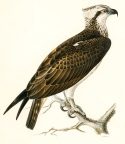Thanks to the Jarriel family, Arundel Rivers can bring you the fascinating lives of a pair of ospreys living on the South River. Welcome them back for 2023! Thank you to Bob O’Dell for supporting the Osprey Cam setup and program.
Sadly, the three hatchlings from the 2023 season have passed away. While this is heartbreaking to watch, it is an important reminder to us all that death is an inevitable and impartial part of life, and is just one of the many things we learn about while engaging with nature. Osprey young have a high mortality rate, with the Royal Society for the Protection of Birds recording a rate of almost 66%.
Thank you for sharing in the joys and sorrows of nature with us. For the time being, the osprey cam will stay up to observe the adult pair still using the nest. We hope for a happier season next year.
BACKGROUND INFO

According to the Jarriel family, this will be the 7th year that this osprey couple have used this nest. The male has more spots on his breast feathers then the female.
In 2021, two of the three eggs hatched in the 2nd week of June. The third egg did not hatch. On June 28th one of the chicks fell out of the nest onto the black shingled roof next to the nest. It was a brutally hot day and we were concerned the chick would overheat on the black roof. The parents could not get it back into the nest, so Heather Jeweler, who is certified in raptor rescue from the Maryland Raptor Conservation Center, came out and placed the chick back into the nest.
In 2020: The ospreys spent 2-3 weeks nest building, then laid their first egg on May 4th, the second egg on May 7, and the third egg on May 11, 2020. The first egg hatched on June 11th, 2020. The second egg, hatched the next day. Sadly, the 3rd egg did not hatch.
SUPPORT THE FEDERATION
Support Arundel Rivers and our efforts to protect the South, West, and Rhode Rivers and help us restore wildlife populations, like these ospreys, and the habitat that supports them, like Underwater Grasses.
2021 "BEST OF" MOMENTS
Last year, we took several short videos of our osprey couple. Here are the best of them for your enjoyment!
Where's My Sibling?
Chick Rescue
Reunited Family Meal
Cleaning with Chicks Underfoot
Lunch time!
Sushi Delivery
Watching Chicks Sleep
Two chicks Pop Up
Keeping the Eggs Warm
2020 "BEST OF" MOMENTS
In 2020, we also took several short videos of our ospreys:
Second fledgling!
Parents Feed Rockish to Teenagers
Invader!
Thanks for the Fish, Now Babysit!
First Egg!
Arranging the Nest
ABOUT OSPREYS
Monogamous, ospreys reach sexual maturity at age three and often mate with the same partner for life. Adults return each year to nest in the same area in which they were born. Experienced breeders begin to arrive at old nest sites in late February or early March, while less experienced breeders arrive later in the season and can spend several weeks finding a mate and nesting site. Males arrive before females. Courtship and nest building or repair begin once a pair has reunited. Large, bulky nests are built using branches, corn stalks, shoreline debris and other materials. Nests are often located near the water on tall structures like dead snags, utility poles, channel markers and nesting platforms.
Females lay three eggs between mid-April and late May, which are speckled with beige and brown spots. Incubation lasts for 38 to 42 days. Eggs do not hatch at the same time. The first chick may hatch as many as five days before the last one, and the oldest chick often dominates over the younger nestlings. If food is limited, this behavior can cause younger chicks to starve to death. Nestlings are brooded and fed fish for about 40 days after hatching. After this point, nestlings begin to resemble adults, but have reddish-orange eyes and feathers edged in buff.
About 55 days after hatching, young begin to fly. Families remain together near the nesting site through July, as fledglings learn to fish. Adults begin to migrate to their wintering grounds as soon as fledglings become independent. Juveniles usually migrate during the last week of August.


Comments:
No comments yet